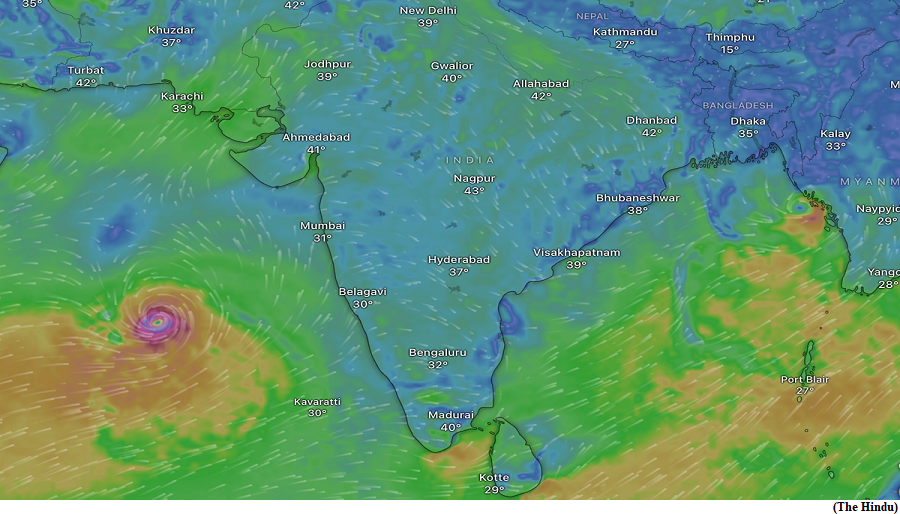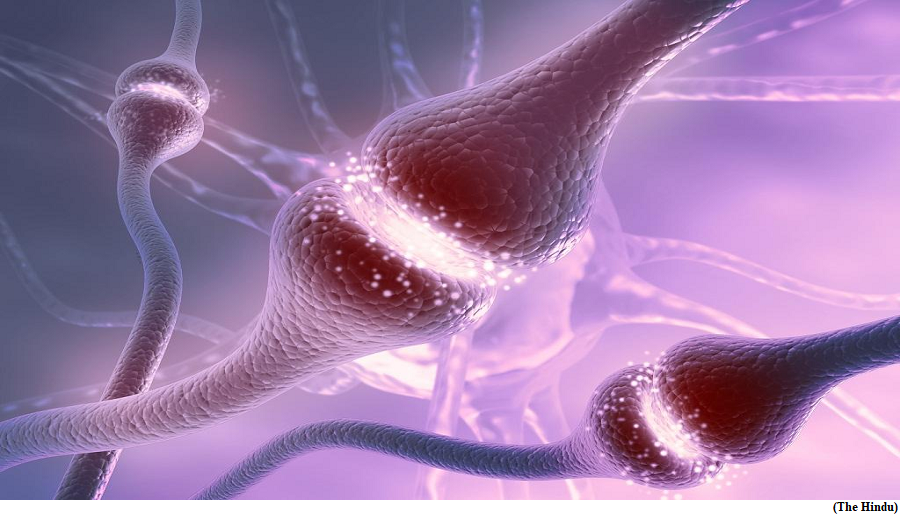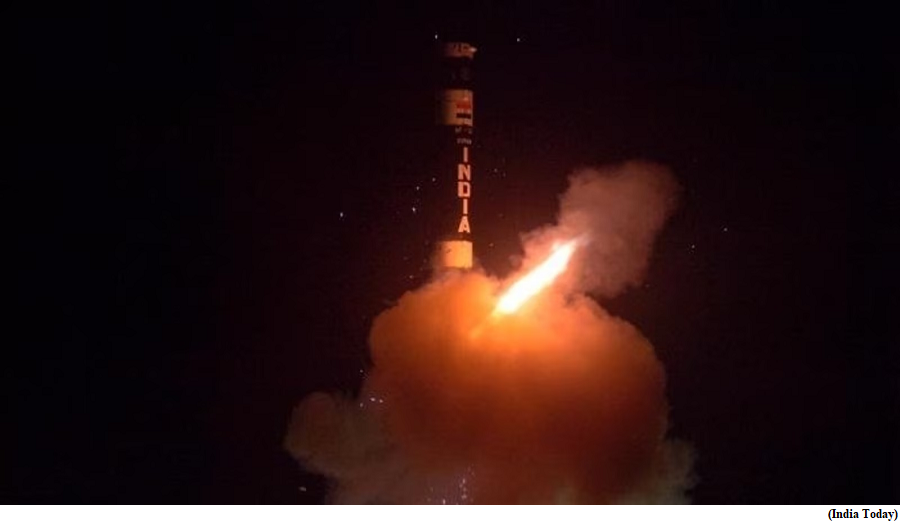Cyclone effect on monsoon onset (GS Paper 1, Geography)

Why in news?
- The cyclone formations in the pre-monsoon cyclone season is in news, closer to the monsoon onset, arguably due to the influence of a warmer Arctic Ocean on the winds over the Arabian Sea.
Impact of global warming:
- The impact of global warming on the monsoons are manifest in its onset, withdrawal, seasonal total rainfall, and extremes. Global warming also affects the cyclones over the Indian Ocean and the typhoons over the northwestern Pacific Ocean.
- The monsoon is of course also affected by the three tropical oceans; Indian, Atlantic, and Pacific; the ‘atmospheric bridge’ from the Arctic; and the oceanic tunnel as well as the atmospheric bridge from the Southern Ocean (a.k.a. the Antarctic Ocean).
- A ‘bridge’ refers to two faraway regions interacting in the atmosphere while a ‘tunnel’ refers to two remote oceanic regions connecting within the ocean.
Why does a cyclone’s position matter?
- Some cyclones in the North Indian Ocean have had both positive and negative impacts on the onset of the monsoon. Since the circulation of winds around the cyclones is in the anticlockwise direction, the location of the cyclone is critical as far as the cyclone’s impact on the transition of the monsoon trough is concerned.
- The monsoon trough is a low-pressure region that is a characteristic feature of the monsoons. For example, if a cyclone lies further north in the Bay of Bengal, the back-winds blowing from the southwest to the northeast can pull the monsoon trough forward, and assist in the monsoon’s onset.
Positive aspect:
- Earlier in 2023, the Bay of Bengal had Cyclone Mocha develop in the first half of May and intensify briefly into a ‘super cyclonic storm’, before weakening rapidly upon landfall.
- Mocha’s northwest to east trajectory over the Bay was the result of unusual anticyclones (which rotate clockwise) that have been parked over the Arabian Sea and the Bay of Bengal since March.
- Mocha dissipated on May 15 and the back-winds helped the monsoon set in on time over the Andaman and Nicobar Islands.
Negative aspect:
- One severe consequence of the anomalous anticyclones since March is that both the Arabian Sea and the Bay of Bengal have warmed by more than 1º C in the pre-monsoon season.
- The late-season cyclone Biparjoy is still chugging along in the warm Arabian Sea and may well rapidly intensify i. before making landfall.
Mawar, Biparjoy, and Guchol:
- Cyclone Biparjoy is not interacting much with the monsoon trough at this time. However, its late birth as well as the late onset of the monsoon are both closely related to typhoons in the northwestern Pacific Ocean. On May 19, Typhoon Mawar was born and dissipated by June 3.
- Mawar qualified as a ‘super typhoon’ and is thus far the strongest typhoon to have taken shape in May. It is also the strongest cyclone of 2023 so far.
- Tropical storm Guchol is now active just to the east of the Philippines and is likely to continue northwest before veering off to the northeast. These powerful typhoons are thirsty beasts and demand moisture from far and wide.
Impact of Mawar:
- Mawar pulled winds across the equator into the North Indian Ocean, setting up southwesterly winds over parts of the Arabian Sea and the Bay of Bengal. ‘Southwesterly’ means blowing from the southwest.
- Southwesterly winds over the Arabian Sea are welcome news: they bring large quantities of moisture onto the Indian subcontinent. On the other hand, southwesterly winds over the Bay of Bengal are bad news for the monsoon.
- The monsoon winds over the southern Bay of Bengal sweep in from the southwest and west, but they turn around and head northwest towards India from the southeast.
- Winds were southwesterly over the entire Bay when Mawar was active. This continues to be the case now due to Guchol, which has become a ‘severe tropical storm’ now.
- Winds have been blowing strongly towards the northeastward over the Bay, a key reason why the monsoon trough has been struggling to reach Kerala.
Way Forward:
- Fortunately, a late monsoon onset does not necessarily indicate a monsoon deficit. Then again, 2023 is unique, with an impending El Niño.
UNESCO to develop ethical framework on neurotech devices
(GS Paper 3, Science and Technology)
Why in news?
- The United Nations Educational, Scientific and Cultural Organization (UNESCO) is all set to host an international conference to develop an ethical framework for the usage of neurotech devices that feed brain-wave data to computers through dry electrodes and implants.
- The first-of-its-kind conference hosted by the UN body will be held at UNESCO headquarters in Paris, France.
- The dialogue will invite senior officials, policymakers, academics, civil society organisations and the private sector to address concerns regarding individual freedom of thought and privacy.

Agenda:
- The 193 member states of the executive board approved proposal to discuss solutions to neurological problems with the help of neurotechnology while simultaneously assessing the threats it poses to human rights and fundamental freedoms.
- There is an urgent need to establish a common ethical framework at the international level, as UNESCO has done for artificial intelligence.
- The conference aims to lay the foundation for a global ethical framework. It will be guided by a report by UNESCO’s International Bioethics Committee on the “Ethical Issues of Neurotechnology”.
DBS:
- Deep brain stimulation (DBS) is approved to treat a number of conditions, such as Parkinson’s disease, essential tremor, dystonia, epilepsy and obsessive-compulsive disorder,” the report stated.
- DBS is also being studied as a potential treatment for major depression, traumatic brain injury, stroke recovery, addiction, chronic pain, cluster headache, dementia, Tourette syndrome, Huntington’s disease and multiple sclerosis.
- The document cautioned that the “possible side effects of DBS are frequently underestimated.
- Complications of DBS fall into three categories: Surgery complications, hardware (device and wires) complications and stimulation-related complications.”
- Manic psychosis, hypersexuality, pathological gambling and mood swings are associated with dopaminergic treatments of some advanced Parkinson’s disease, and there have been reports that these are made worse by DBS.
- UNESCO strives to develop a framework similar to the established global ethical frameworks on the human genome (1997), human genetic data (2003) and artificial intelligence (2021).
Risks posed by AI tech:
- UNESCO acknowledged “the pervasiveness of AI technologies and the risks they pose to people, democracies and jobs. The convergence of neural data and artificial intelligence poses particular challenges, as already recognised in UNESCO’s AI standard.
- The dialogue will also be guided by a yet-to-be-released UNESCO study that documents evidence on the neurotechnology landscape, trends and innovations.
Way Forward:
- The new regulations be developed over neurotechnology usage in fields other than medicine. This is particularly in the areas of well-being, marketing and workplaces.
India successfully test-fires night launch of ballistic missile 'Agni Prime'
(GS Paper 3, Defence)
Why in news?
- India has successfully carried out a night launch of new generation nuclear capable ballistic missile 'Agni Prime' from the Abdul Kalam Island off the coast of Odisha.
- The first pre-induction night launch of the missile with a strike range of 1,000 to 2,000 km was carried out on Wednesday by the Defence Research and Development Organisation (DRDO) and the elite strategic forces command.

Agni-V:
- In December, India successfully test-fired Agni-V missile that can strike targets at ranges up to 5,000 km.
- Agni-V can bring almost the entire Asia including the northernmost part of China as well as some regions in Europe under its striking range.
- The Agni 1 to 4 missiles have ranges from 700 km to 3,500 km and they have already been deployed.
- In April, India successfully carried out the maiden flight trial of an endo-atmospheric interceptor missile from a ship off the coast of Odisha in the Bay of Bengal as part of its ambitious ballistic missile defence programme.
Key Highlights:
- The Agni Prime is a two-stage canisterised solid propellant ballistic missile with dual redundant navigation and guidance systems.
- It first underwent testing in June 2021 and has a range of 1000 to 2000 km. Compared to the older Agni series missiles, it is lighter.
- This successful flight test has paved the way for the induction of the system into the Armed Forces.
Significance:
- The purpose of the trial of the sea-based missile was to engage and neutralize a hostile ballistic missile threat thereby elevating India into an elite club of nations having such a capability.
- India has been developing capabilities to intercept hostile ballistic missiles both inside and outside the earth's atmospheric limits.
Way Forward:
- The test-firing met all the desired objectives and that it paved the way for induction of the system into the armed forces.
- The test-firing of the missile came amid India's lingering border row with China.




